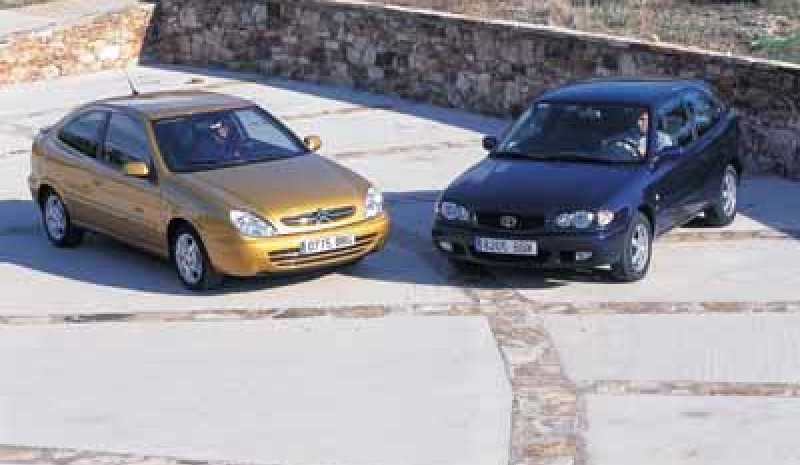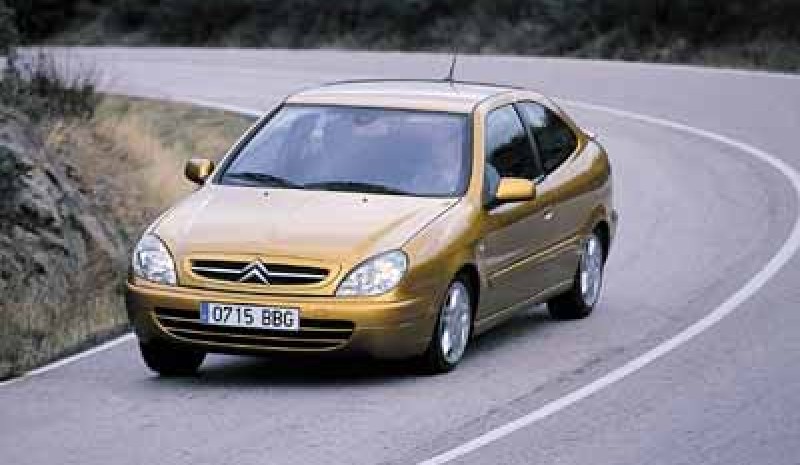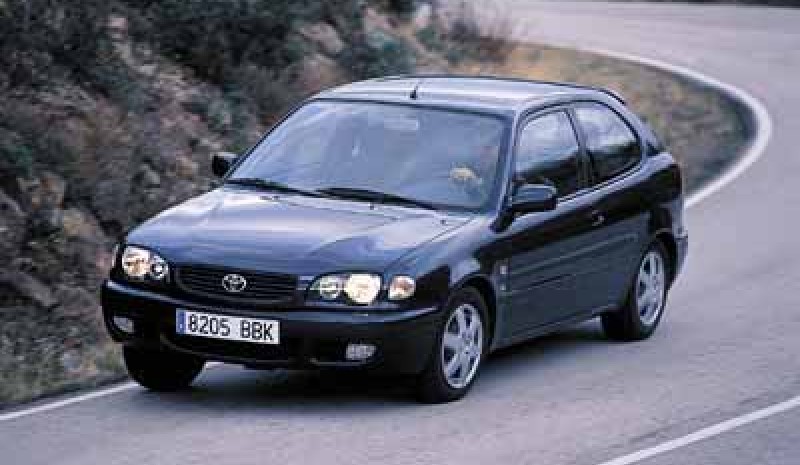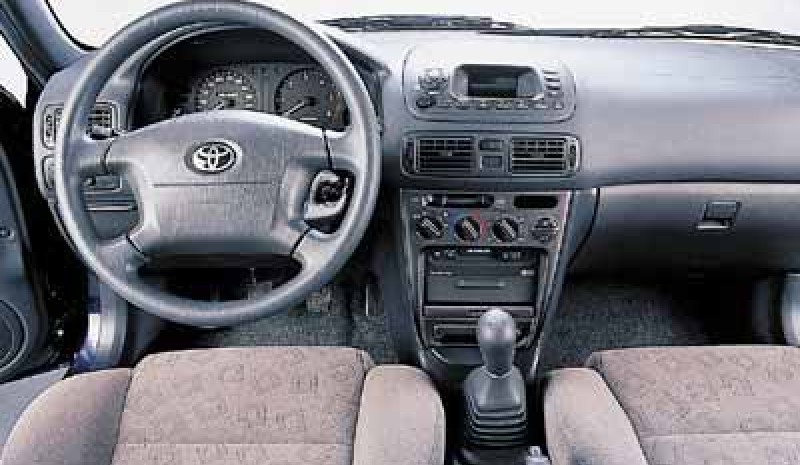Comparison: Citroen Xsara Coupe 2.0 HDi VTS / 3p Toyota Corolla 2.0 D4-D Sol
The adoption of a modern direct injection diesel engine "common rail" 90 hp enables the Corolla in the group increased demand for its segment; a good argument to be measured with the sales leader, renewed Xsara HDi, which premieres image and equipment upgrades and security.
With greater or lesser dedication, Japanese brands are taking positions to meet the inexhaustible Diesel demand has emerged in recent years in Europe. For Japanese manufacturers, who would follow shortly Koreans consolidated in the Old Continent inevitably happens to offer diesel engines. Since the mechanical diesel in passenger cars are used almost exclusively in Europe, there are manufacturers who still renounce their ranges offer this type of engine -case Subaru-; others face the current scenario -Mitsubishi looking for European partners with Renault, Honda has filed a Rover engine for Accord-, and finally there are those who are committed to developing their own mechanical, if Mazda, Nissan and Toyota. Of the latter, it is to praise the efforts of Toyota stand up to the best European specialists, with their recent family D4-D engine with latest technology "common rail" and 4-valve per cylinder.
The engine is derived Corolla debuts bright 2.0 D4-D 110 hp Avensis, without "intercooler" to cool the air feeding the engine, turbo and lower pressure new mapping, leaves the power in 90 CV. The known HDi Xsara presents similar technical, technology "common rail" and also 90 hp. The most obvious difference is the more conventional cylinder head 2 valves per cylinder, a circumstance that marks differences in these mechanical performance. As good candidate to lead the market, both engines have a very smooth running, little sound, just vibrations to be transmitted Diesel and perform exemplarily in long marches from just 1,700 rpm. In practice, are developments of change that determine a separation between these two engines, especially in view of the timer and the supplier, because for pleasure of use, it is difficult to choose one of the two. The Xsara has chosen a rather long development in 5th theoretically looking to reduce consumption and noise levels. But the moment of truth, the Corolla D4-D with your best tight end development is not only able to recover and advance in all measurements in less time up to 2.3 seconds less, equivalent to 70 meters in maneuver 80 to 120 km / h in 5ª- but open traffic has obtained a lower consumption (0.7 liters less than half). His 5th gear is more capable when crown repechos, forward and recover, saving reductions or stepping on the accelerator with more intensity. Only the tables are reversed when driving very fast, demanding maximum performance engines, a situation where the Xsara has barely reached the 9 liters of media when the Corolla exceeds 10 liters. And this is extensible to any type of track.
In the dynamic section, each model has its own distinct personality. In short, we could say that the Corolla is a comfortable model for suspensions and Xsara VTS finish in our test unit, it has a sportier dynamic orientation or reflected on their best behavior. The Corolla is a car with a very nice overall feel. Their suspensions are on the soft, smooth steering and shift touch and clutch-from hydraulic-drive eventually set off with high pleasure of use. Normal driving behavior is noble and secure, rewarding driving comfort but, as we force the march on winding paths, the limit appears before. Corolla reactions are predictable as the situation, time may require greater attention by the agility of your rear is not force it. If wide roads and smooth curves conveys confidence no matter much the rate at which circulemos, tortuous paths in this circumstance is somewhat disconcerting to medium / high speed.
Corolla is initially understeer on corner entry, but the correction to recover drawn, lifting off the throttle unleashes an immediate trend Oversteer. However, we are talking about a reaction that only appears forcing the march. The Xsara is firmer suspension and shows a tread aplomada. It does not offer the sweetness of the Corolla when absorb bumps, but you may not cross out of rough asphalt uncomfortable, and yes more precise in all circumstances. In short, it is very close to the ideal balance. The Xsara also characterized by its directional rear axle very active, but the reactions are more balanced. Its front end is more incisive and suspensions touch better informs the driver steps on where and how the car, something that does not happen so faithfully in "filtered out" Corolla. Supports the Xsara are faster and just understeer, but the defense also helps close the curve. It is also true that this Citroën sportier looking and effective mood for Xsara Coupé, which mounts larger wheels -15 inch, wider tires sports specifications and a variable direction depending on the speed, which helps transmit more driver information, although still somewhat city can be hard.
In the brake section, both models offer very good response power and resistance to fatigue, but in the case of Corolla distances lengthen over-the account 81 meters from 140 km / h is not a good cifra-, while Xsara that can be described as remarkable. Corolla tires, midrange and anything oversized, have some responsibility here. Other sportier profile help improve braking distances and surely attenuate the initial understeer tendency.
The driving position in both models is well achieved, but the Xsara set-up offers more opportunities and better seats: wider, with better lateral support and memory throwback to rest them for access to the rear seats. Another important difference is in the ability of the bellboys, more generous in the Citroën that, not surprisingly, offers larger outer dimensions than the Toyota (Corolla is short wheelbase), which accrues an interior with greater habitability.
Our two protagonists are standard equipment most complete of their respective ranges, although quite complete detail the renewed Xsara and a more complete list of options (offers, inclusive, satellite navigation). If the starting price of the Xsara is higher by 200,000 pesetas, with the current promotion of 500,000 pesetas 300,000 pesetas it is below the Corolla. This has an excellent engine and a general touch more refined vehicle even more exclusive image of our country, but in any case, its best virtues serve to overshadow the Xsara.
With greater or lesser dedication, Japanese brands are taking positions to meet the inexhaustible Diesel demand has emerged in recent years in Europe. For Japanese manufacturers, who would follow shortly Koreans consolidated in the Old Continent inevitably happens to offer diesel engines. Since the mechanical diesel in passenger cars are used almost exclusively in Europe, there are manufacturers who still renounce their ranges offer this type of engine -case Subaru-; others face the current scenario -Mitsubishi looking for European partners with Renault, Honda has filed a Rover engine for Accord-, and finally there are those who are committed to developing their own mechanical, if Mazda, Nissan and Toyota. Of the latter, it is to praise the efforts of Toyota stand up to the best European specialists, with their recent family D4-D engine with latest technology "common rail" and 4-valve per cylinder.
The engine is derived Corolla debuts bright 2.0 D4-D 110 hp Avensis, without "intercooler" to cool the air feeding the engine, turbo and lower pressure new mapping, leaves the power in 90 CV. The known HDi Xsara presents similar technical, technology "common rail" and also 90 hp. The most obvious difference is the more conventional cylinder head 2 valves per cylinder, a circumstance that marks differences in these mechanical performance. As good candidate to lead the market, both engines have a very smooth running, little sound, just vibrations to be transmitted Diesel and perform exemplarily in long marches from just 1,700 rpm. In practice, are developments of change that determine a separation between these two engines, especially in view of the timer and the supplier, because for pleasure of use, it is difficult to choose one of the two. The Xsara has chosen a rather long development in 5th theoretically looking to reduce consumption and noise levels. But the moment of truth, the Corolla D4-D with your best tight end development is not only able to recover and advance in all measurements in less time up to 2.3 seconds less, equivalent to 70 meters in maneuver 80 to 120 km / h in 5ª- but open traffic has obtained a lower consumption (0.7 liters less than half). His 5th gear is more capable when crown repechos, forward and recover, saving reductions or stepping on the accelerator with more intensity. Only the tables are reversed when driving very fast, demanding maximum performance engines, a situation where the Xsara has barely reached the 9 liters of media when the Corolla exceeds 10 liters. And this is extensible to any type of track.
In the dynamic section, each model has its own distinct personality. In short, we could say that the Corolla is a comfortable model for suspensions and Xsara VTS finish in our test unit, it has a sportier dynamic orientation or reflected on their best behavior. The Corolla is a car with a very nice overall feel. Their suspensions are on the soft, smooth steering and shift touch and clutch-from hydraulic-drive eventually set off with high pleasure of use. Normal driving behavior is noble and secure, rewarding driving comfort but, as we force the march on winding paths, the limit appears before. Corolla reactions are predictable as the situation, time may require greater attention by the agility of your rear is not force it. If wide roads and smooth curves conveys confidence no matter much the rate at which circulemos, tortuous paths in this circumstance is somewhat disconcerting to medium / high speed.
Corolla is initially understeer on corner entry, but the correction to recover drawn, lifting off the throttle unleashes an immediate trend Oversteer. However, we are talking about a reaction that only appears forcing the march. The Xsara is firmer suspension and shows a tread aplomada. It does not offer the sweetness of the Corolla when absorb bumps, but you may not cross out of rough asphalt uncomfortable, and yes more precise in all circumstances. In short, it is very close to the ideal balance. The Xsara also characterized by its directional rear axle very active, but the reactions are more balanced. Its front end is more incisive and suspensions touch better informs the driver steps on where and how the car, something that does not happen so faithfully in "filtered out" Corolla. Supports the Xsara are faster and just understeer, but the defense also helps close the curve. It is also true that this Citroën sportier looking and effective mood for Xsara Coupé, which mounts larger wheels -15 inch, wider tires sports specifications and a variable direction depending on the speed, which helps transmit more driver information, although still somewhat city can be hard.
In the brake section, both models offer very good response power and resistance to fatigue, but in the case of Corolla distances lengthen over-the account 81 meters from 140 km / h is not a good cifra-, while Xsara that can be described as remarkable. Corolla tires, midrange and anything oversized, have some responsibility here. Other sportier profile help improve braking distances and surely attenuate the initial understeer tendency.
The driving position in both models is well achieved, but the Xsara set-up offers more opportunities and better seats: wider, with better lateral support and memory throwback to rest them for access to the rear seats. Another important difference is in the ability of the bellboys, more generous in the Citroën that, not surprisingly, offers larger outer dimensions than the Toyota (Corolla is short wheelbase), which accrues an interior with greater habitability.
Our two protagonists are standard equipment most complete of their respective ranges, although quite complete detail the renewed Xsara and a more complete list of options (offers, inclusive, satellite navigation). If the starting price of the Xsara is higher by 200,000 pesetas, with the current promotion of 500,000 pesetas 300,000 pesetas it is below the Corolla. This has an excellent engine and a general touch more refined vehicle even more exclusive image of our country, but in any case, its best virtues serve to overshadow the Xsara.




